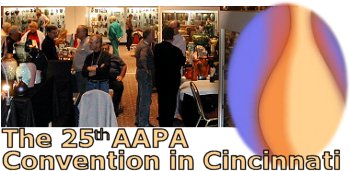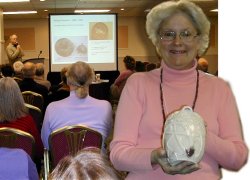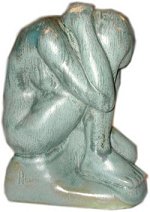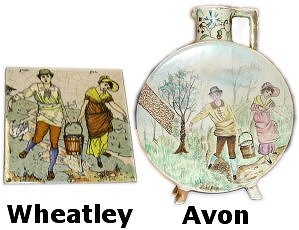Sunday, April 24, 2005

As my British friends would say, I had a simply marvelous time at this year’s American Art Pottery Convention in Cincinnati, Ohio’s spectacular art deco Rockefeller Center precursor, the Neatherland Hilton hotel.
Newly elected Association President Patti Bourgeois, in remarks at this morning’s business meeting, reported the convention a success and Association membership on an upswing following a modest six-year decline.
Some members, at this morning’s meeting, expressed frustration with seemingly lackluster interest by Cincinnati’s general public despite relatively strong promotion of the convention and pottery sale in the local media.
Remedies were suggested including the creation of a general admission ticket to allow the public to attend convention lectures, the creation of educational lectures specifically geared for a general audience and particular marketing strategies geared toward increasing the American Art pottery’s decorative profile among younger people.

Wheatley lecturer Jim Graham
Wheatley Pottery lecturer and Washington DC resident Jim Graham mentioned, during his slide-beset lecture, that T. J. Wheatley donated two of his limoges pots to the Smithsonian Institution and stated that the nation’s attic holds “all [American art] pots in storage”.
Aside from an approach to the decorative arts arbiters at Martha Stewart Omnimedia and having Association representatives or literature available at the major annual art house auctions across the country, I feel that a modest AAPA crusade within the pages of it’s bimonthly magazine the Journal urging the Smithsonian and elected representatives to make the Institution’s stored American pottery collection available to the White House and Congress in a manner similar to the loan system in place with paintings and other decorative objects would do a great deal to increase American pottery’s public profile.
I can recall the Clinton’s had a large Dale Chihuly glass bowl on display in the Family Quarters during their residence in the White House but I cannot recall an elected official ever displaying one piece of America’s world-renowned pottery except for President Dwight D. Eisenhower who was presented with Rookwood elephant bookends in 1955 .
Aside from drinking in the many beautiful historic and modern pottery exhibits and renewing friendly acquaintances with tile dealers and authors Wendy Fowler and Sandy Harvey of Massachusetts and major Kenton Hills Porcelains collector and antique dealer Kendall Scally from Louisville, Kentucky, I was also pleased to speak with the authors of Kenton Hills Porcelains, The Story of a Small Art Pottery Nick and Marilyn Nicholson and to have continued conversation with the delightful Bob and Mary Ellen Seery from New Mexico, experts and convention lecturers on the early Cincinnati Potteries.
Indeed, after these intensive days, I’m exhausted and suffering from mild sensory overload.

Jensen lecturer Eldred is shown with a Jensen painting.
The standard of excellence in informational presentations set by Anita Ellis at the opening banquet was met in the fascinating lectures I attended.
Lisa Eldred offered some highly interesting insights into the mind of the Rookwood Pottery’s modernist Jens Jensen.
I was particularly interested in the “constraints" Jensen felt from Rookwood management regarding his abstract female nudes and amused by a management conflicted with Jensen’s productive and lucrative output, often decorating 15 vessels per day, and the Danish immigrant’s interest in the nude female form.
Some things seem to never change in Cincinnati.
Before Jensen and the relatively recent and infamous contre-temps with Robert Mapplethorpe’s photography, I recall that Cincinnati Impressionist Frank Duveneck caused a turn of the 20th century morals crisis with a pastel female nude entitled Siesta purchased to decorate a popular downtown saloon.
After rumors of the painting spread to the wives of the bar’s patrons, saloon owner Theodore Foucar decided to donate the painting to the Cincinnati Art Museum saying, “That girl was too naked for my saloon, but she was not too naked for high society.”

As Bob lectures, Mary Ellen displays a 1903 M.Louise McLaughlin porcelain.
Bob and Mary Ellen Seery punctuated their remarks with many examples of early Cincinnati pottery from their vast collection during a fascinating lecture titled Formed in Clay: A History of Cincinnati Seen Through It’s Potteries, 1870’s to 1960’s.

While particularly intrigued with this beautiful, rare and quite heavy Avon Pottery figural, I was most interested in the Seery’s examples of creative cross-pollination between the artists and craftsmen of the early potteries.

The suspected diverse use made of McLaughlin and Longworth’s low and high fire kilns at the Coultry Pottery prior to 1880 seems to have continued into the 20th century as graphically illustrated by the nearly identical artwork evidenced between the pictured Walter Crane illustration on a Wheatley tile and a strikingly similar design on the later piece of Avon Pottery.
I was also awestruck by the various and beautiful exhibits by currently working American potters including the Hog Hill Pottery in Vale, NC, the Chris Powell Pottery in Westerville, OH, Door County Handworks Studio from Madison, WI and the Turtle Island Pottery in Black Mountain, NC and disappointed that many local Cincinnati potters elected not to exhibit at this year’s convention.
If you feel a nascent interest in American ceramics, I urge you to explore the AAPA's web page and to join and participate or lurk in the Art Pottery discussion group.
Images: sean


